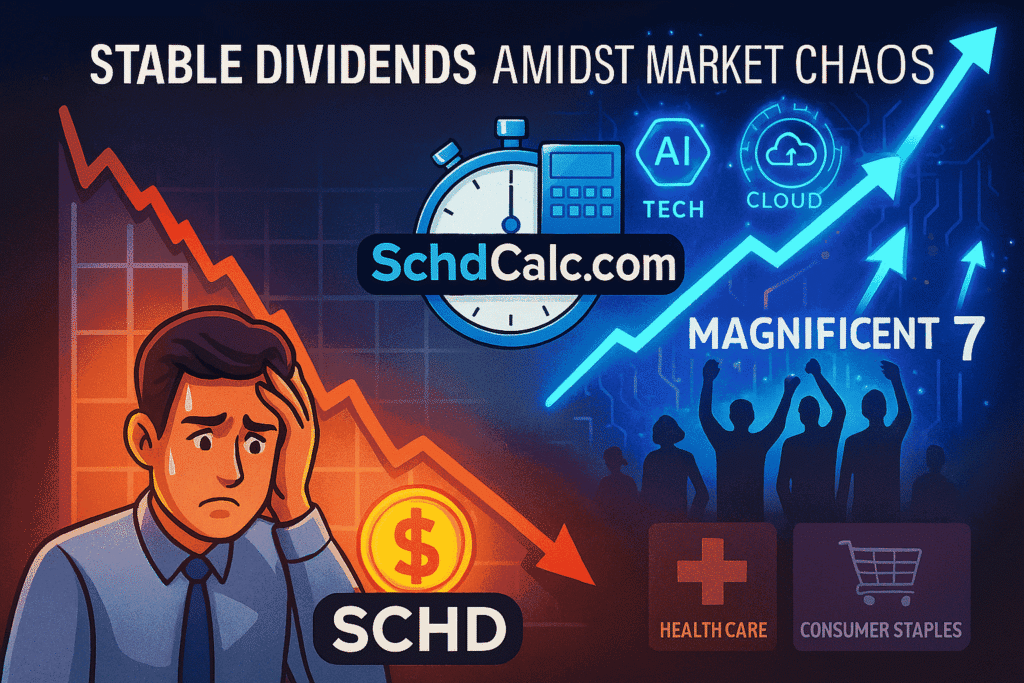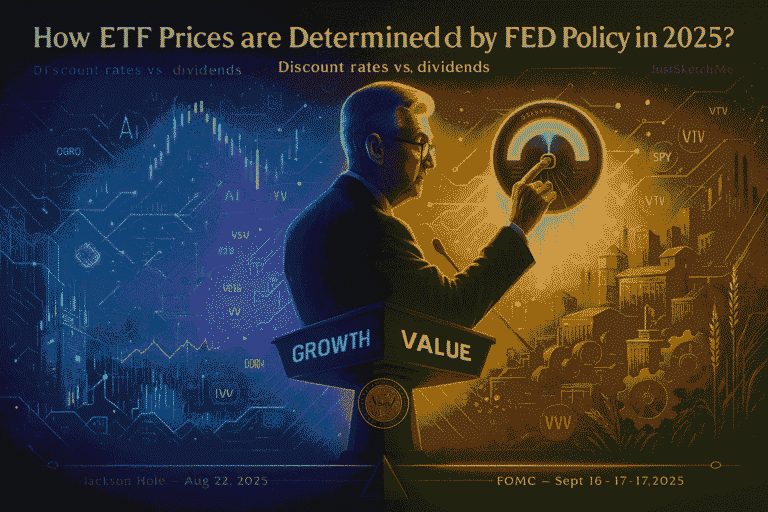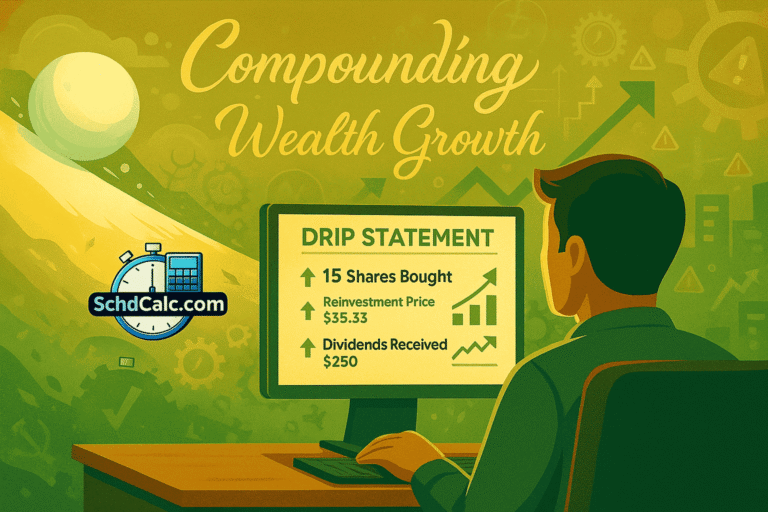As an investor if you have had the personal experience of the stock market then you may know about the complexities of the market and I have closely observed the recent performance of the Schwab U.S. Dividend Equity ETF (SCHD). As you also know SCHD’s dividend pay continues to be a primary attraction which is essential for income-focused investors but now it has faced a period of notable underperformance in 2025. Many investors are now asking what is happening to SCHD and what this means for their portfolios.
Here we will explain the factors behind the SCHD’s recent issues, analyse its underlying holdings and sector exposures and also provide you with insights about what the future might hold for this popular dividend ETF.
What Has Caused SCHD to Underperform the Market in 2025?
The underperformance of SCHD in 2025 has many reasons and it has faced different challenges when compared to other major market indexes.
1. Structural Misalignment with Market Leadership:
The overall stock market (especially the S&P 500) has been doing well but this success is mostly driven by a small group of fast-growing tech and AI driven companies. These companies focus on growing their revenue and reinvesting in their research work instead of paying large dividends. However SCHD does not have these types of companies in its portfolio because it focuses on more stable and dividend paying companies.
2. Disparity in Growth Rates:
In the first quarter of 2025, the overall growth of the S&P 500 index in earnings is +7.2% and in revenue is +1.2%. But most of this growth came from a small group of seven or eight big tech companies, which are often called the “Magnificent 7/Great 8.” In these companies we have seen a much higher growth rate of 28.9% in earnings and 12.7% in revenue than SCHD’s holdings whose growth remains slower but stable. Even though its growth rate is lower than that of other sectors, SCHD’s history has shown strong resilience. The rest of the S&P 500 have seen a decline with earnings falling by -5.2% and revenue dropping by -1.8%.
As SCHD focuses on dividends and its biggest holdings grew at a slower rate and therefore its revenue is growing by 5% and earnings growing by 7%. This shows that SCHD’s holdings did grow but not by much as compared to the huge growth in the tech sector.
3. Market Preference for Capital Appreciation:
The current market environment is strongly focused on capital growth stocks and it is especially in the technology and AI sectors. These types of stocks are now growing and also have good valuations which makes dividend-focused investments like SCHD less attractive.
As of July 2025 SCHD’s yield is about 3.8% which is also less than 4%. Dividends and record share buybacks from big tech companies help the S&P 500 with a good return. This dynamic change accurately reflects the recent trends in the market.
4. Growth over Value Preference:
The U.S. stock market in 2025 continues to reward growth stocks which are particularly in the technology and AI sectors. These sectors now have good valuations and dividend-focused funds like SCHD are underperforming in this regard. As an investor of the SCHD ETF you may know that the SCHD is focused on the well-established companies that pay dividends and it does not mean to focus on heavily weighted sectors that are growing quickly.
As a result while growth stocks drive market gains but SCHD is falling because it does not have much exposure to these new areas and the market is still prioritising more value on capital appreciation than dividend income.
SCHD Top Holdings Breakdown 2025
In the SCHD’s investment strategy focuses on high-quality U.S. companies with a history of paying dividends. In this fund has 100 stocks. As of July 2025 this ETFs making their biggest investments are mostly in health care, energy, and financial sectors. This year these sectors have mostly fallen due to the tech-driven market leaders. Below is a breakdown of some of SCHD’s top holdings as of July 18, 2025.
| Rank | Company Name | Ticker | Sector | % of Assets | Market Value |
| 1 | Texas Instruments | TXN | Technology | 4.36% | $3.1B |
| 2 | PepsiCo | PEP | Consumer Staples | 4.24% | $3.0B |
| 3 | Chevron | CVX | Energy | 4.23% | $3.0B |
| 4 | ConocoPhillips | COP | Energy | 4.15% | $2.9B |
| 5 | Cisco Systems | CSCO | Technology | 4.08% | $2.9B |
| 6 | Merck & Co. | MRK | Health Care | 4.00% | $2.8B |
| 7 | Amgen | AMGN | Health Care | 3.99% | $2.8B |
| 8 | AbbVie | ABBV | Health Care | 3.93% | $2.8B |
| 9 | Bristol Myers Squibb | BMY | Health Care | 3.85% | $2.7B |
| 10 | Coca-Cola | KO | Consumer Staples | 3.80% | $2.7B |
Sector Allocation
| Sector | % of Portfolio |
| Energy | 19.23% |
| Consumer Staples | 18.81% |
| Health Care | 15.53% |
| Industrials | 12.50% |
| Information Technology | 9.00% |
| Financials | 8.91% |
| Consumer Discretionary | 8.38% |
| Communication Services | 4.52% |
| Materials | 3.07% |
| Utilities | 0.04% |
Should I Buy, Sell, or Hold SCHD After Its 2025 Drop?
The decision to buy, sell or hold SCHD after its 2025 downfall depends heavily on your financial goals, risk tolerance and investment horizon. There is no proper answer but as an investor you can make an informed decision by properly analysing.
1. Arguments for Holding SCHD:
The main reason that most investors like SCHD is that it pays dividends on a regular basis and this ETF only invests in companies that are financially stable. Even though it has recently underperformed in price growth but still it has a higher dividend yield than the S&P 500. So this ETF provides you with a good choice for retirees or people who need passive income. This long-term investment strategy from SCHD will give you steady growth and dividends.
The ETF follows a quality and dividend growth strategy by investing in those companies that are financially strong and have a history of increasing their dividends. This long-term focus gives you a strong message to the investors even when the market is not doing well. The recent drop in performance of this ETF could be seen as a temporary setback. If you are a potential investor and also understand the market fundamentals then you will get potential rewards as market cycles shift back to value and income-generating assets.
2. Arguments for Buying SCHD:
For those looking to buy more SCHD then this 2025 price drop gives you an opportunity to buy it but before buying, you must analyse it and also take advice from a market expert. Therefore investors can also use SCHD Calculator tools to calculate how much money they might make from this price drop. Dollar-cost averaging also helps you where investors invest fixed amounts regularly. This investment can be effective during downturns because it lowers the average cost per share and may lead to higher returns in the future. Therefore the current downfall of the ETF increases the dividend yield and it will attract new investors to invest in it. So if you are a long-term investor who believes in SCHD’s future and also knows about its past trend and fundamentals then you can ignore the short-term market changes.
3. Arguments for Selling SCHD:
If your goal changes from dividend income to aggressive capital growth then you might think about selling the SCHD ETF and it totally depends on you. The investors those who want higher returns might be worried that it does not perform properly as compared to the growth indices like the S&P 500 because the SCHD ETF currently does not have as many investments in the tech and AI stocks. So if you want to make money in the market then you also diversify your investment to a broader market index or a growth-focused ETF might be a better option for you.
Also if your risk tolerance goes down or you are getting close to retirement then it might be smart to sell your assets that are not doing well to protect your money. But before making such decisions you should discuss with the market expert and then you take your decision.
SCHD’s underperformance in 2025 has been a significant topic of discussion among investors which has led many to rethink its place in their portfolios. There are a few reasons why returns have been down as discussed here and so you should also research and analyse them before taking the final step.



